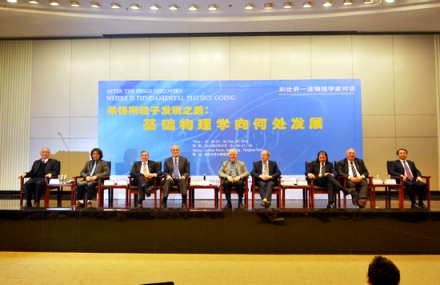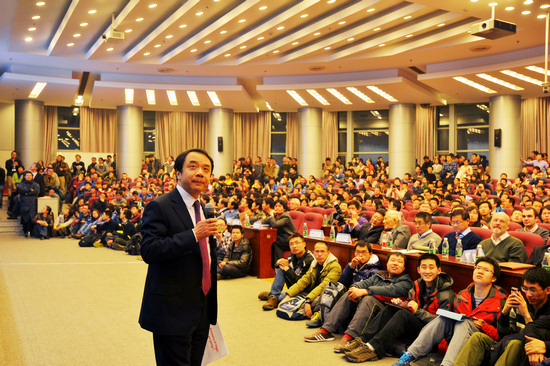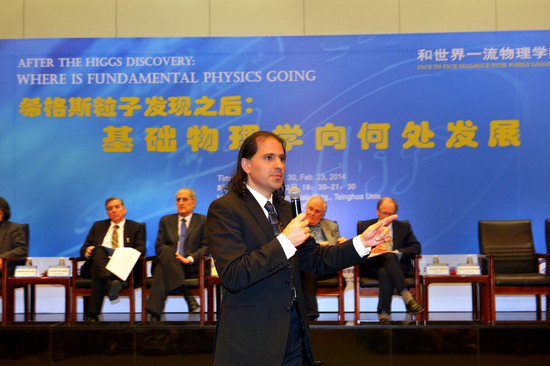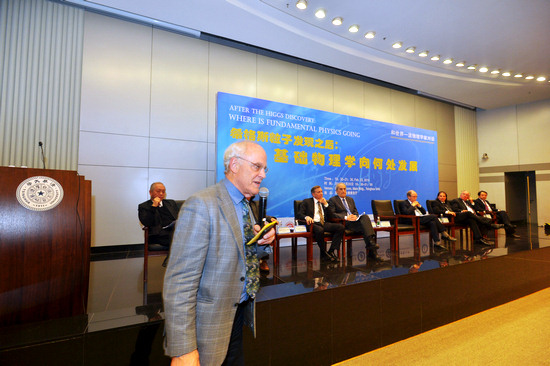中国科学院高能物理研究所(中科院高能所)2月24日至25日在北京举行未来环形正负电子对撞机研讨会,与会科学家们讨论在中国建造下一代环形正负电子对撞机的可能性,以满足被誉为“上帝粒子”的希格斯粒子发现之后高能物理研究领域对大型科学实验设备的需求。
“下一代环形正负电子对撞机未来可改造成质子-质子对撞机,将推动高能物理研究领域朝更高精度测量、更高能量探索方向发展。”中科院高能所所长、2014年潘诺夫斯基实验粒子物理学奖得主王贻芳研究员说,未来的环形正负电子对撞机瞄准希格斯粒子发现后对撞机实验的核心前沿物理问题,其科学目标是精确测量希格斯粒子的性质以及搜索标准模型背后更基础的物理规律。
一方面,中科院高能所现有改造后的北京正负电子对撞机还有8年运行使命,下一代环形正负电子对撞机建成后可实现升级换代;另一方面,大型科研基础设施的建造运行,一般都需要5到10年的准备时间。因此,中国目前着手规划下一代环形正负电子对撞机的设计建造工作正是时候。
这位领导建设北京谱仪和大亚湾中微子实验的科学家介绍说,下一代环形正负电子对撞机计划能量可达到240GeV(1GeV为10的9次方电子伏特),产生上百万个希格斯粒子,这一能量也是目前运行中的北京正负电子对撞机的60倍。从长远来看,环形正负电子对撞机方案可以改造为大型质子对撞机,其能量比目前正在运行的欧洲核子中心的大型强子对撞机大7倍,将能提供极好的粒子物理研究机会,使中国成为粒子与加速器物理领域世界领导者。
中国科学家最早于2012年提出建造下一代环形正负电子对撞机并适时转为质子对撞机的方案后,在国际上引起巨大反响。在中科院高能所未来环形正负电子对撞机研讨会前夕,包括诺贝尔物理学奖、菲尔兹奖得主等在内的近10位世界一流物理学家相聚北京,围绕“希格斯粒子之后,基础物理学向何处去”主题展开对话,为中国建造下一代环形正负电子对撞机“助阵”。
菲尔兹奖得主、哈佛与清华大学丘成桐教授说,希格斯粒子有人叫它“上帝粒子”,今天也有一个“上帝”赐给的良机,就是参加建造下一个大型对撞机。意大利国家研究委员会主席、欧洲核子研究中心前主任鲁加诺·玛亚尼(Luciano Maiani)表示,中国有机会建造未来环形正负电子对撞机,这是中国高能物理发展的机遇。
“希格斯粒子的发现和更多认知,将会为我们的认识再次带来一场革命。”诺贝尔物理学奖得主、荷兰皇家科学院院士杰拉德·特·胡夫特(Gerard’t Hooft)指出,下一代高能物理对撞机的建设,将会为这场革命带来重要影响。
美国普林斯顿高等研究院教授、中科院高能所高能物理前沿研究中心主任尼玛·亚哈尼·哈米德(Nima Arkani-Hamed)认为,探索更微观的世界,唯一的方法是建立更大的环型加速器,第一步可以进行正负电子对撞实验,会产生很多希格斯粒子,带动相关研究;第二步可以在加速器上进行质子-质子对撞实验,从而探测更高的能量区域,观察更微观的尺度。
诺贝尔物理学奖得主、美国物理学家戴维·格罗斯(David Gross)把建造下一代环形正负电子对撞机的梦想称做“中国的伟大加速器”。“这会和万里长城一样引人瞩目,会比万里长城的作用更大”,它会在科学技术各领域有突破和发现,“如果中国建造了这个加速器,世界上的许多科学家会来这儿帮忙和工作”。
菲尔兹奖得主、美国普林斯顿高等研究院教授埃德沃德·威腾(Edward Witten)说,如果在目前对撞机的能量上,再提高一个数量级,将会在揭示自然界的奥秘上推前一大步,“现在正是中国成为这一领域领袖的最好时机”。
美国加州大学圣巴巴拉分校教授、2013年基础物理奖获得者约斯夫·英坎德拉(Joseph Incandela)称,建造新的高能加速器将非常重要,将深入理解人类赖以生存的宇宙。“在国际高能物理学界的下一步发展计划中,期待中国扮演一个举足轻重的角色”。
“希格斯粒子发现后,中国有了一个机会,利用成熟的环形加速器技术就可以建造一个‘希格斯工厂’,来研究世界上最先进的研究课题。”王贻芳表示,只有研究清楚希格斯粒子的性质,才有可能了解粒子物理未来的方向。
Scientists Aim at Next-Generation High Energy Circular Collider
Nine leading physicists from around the world gathered for a panel discussion at Tsinghua University in Beijing on Feb. 23 to talk about new physics opportunities after the discovery of the Higgs boson.

Top physicists have face-to-face discussion on future of fundamental physics(Image by LIU Jie, IHEP)
Chaired by Shing-Tung Yau, a Fields medalist, the panelists included Nima Arkani-Hamed, David Gross, Gerard 't Hooft, Joseph Incandela, Luciano Maiani, Hitoshi Murayama, WANG Yifang and Edward Witten, who are all either Nobel laureates, Fields medalists or Fundamental Physics Prize winners.
One topic of discussion was the circular electron-positron collider(CEPD), which was proposed by the Chinese high energy physics community in 2012 and has received a warm response from the international physics community. The next-generation high energy circular collider could be upgraded beyond the Higgs factory to a future circular high energy proton-proton collider.
The main physics objectives of the future high energy circular accelerator are the precise measurement of Higgs properties as well as tagging possible new physics signals. "Only after we have understood the properties of the Higgs particle can we find the direction of future particle physics research,” said WANG Yifang, director of the Institute of High Energy Physics and the winner of the 2014 W.K.H. Panofsky Prize in Experimental Particle Physics.
Nima Arkani-Hamed, winner of the 2012 Fundamental Physics Prize, said the only method for exploring the micro-world is to build a larger circular accelerator. The first step could be an electron-positron-collision experiment and the second step could be a proton-proton collision at a higher energy range. Then the world could be observed at a more microscopic scale.
Gerard ‘t Hooft, winner of the Nobel Prize in Physics in 1999, said, “The discovery and the precise measurement of the Higgs particle will revolutionize our understanding of nature, and the next generation high energy circular collider will have unprecedented influence over this revolution.”
Fields Medalist Edward Witten, noting the great potential for a circular collider to reveal more secrets of nature, said, “Now is the best opportunity for China to become the leader in this field.”
David Gross, Nobel Laureate in Physics, said the future circular collider, which he called “the Great Accelerator,” could be compared to “the Great Wall” in China. If China built the collider, scientists from all around the world would join and work together. New breakthroughs and discoveries could be achieved in the future.
The panel discussion was held in conjunction with a workshop, held from February 24 to 25 at the Institute of High Energy Physics, that focused on the physics case for future circular colliders, as well as discussions on how to synchronize domestic theoretical particle physics efforts with the planning and design of future circular machines.

WANG Yifang, director of the Institute of High Energy Physics and the winner of the 2014 W. K. H. Panofsky Prize in Experimental Particle Physics introduces CEPC(Image by LIU Jie, IHEP)

Nima Arkani-Hamed, the winner of the 2012 Fundamental Physics Prize at the panel discussion (Image by LIU Jie, IHEP)

David Gross, Nobel Laureate in Physics at the panel discussion(Image by LIU Jie, IHEP)





















